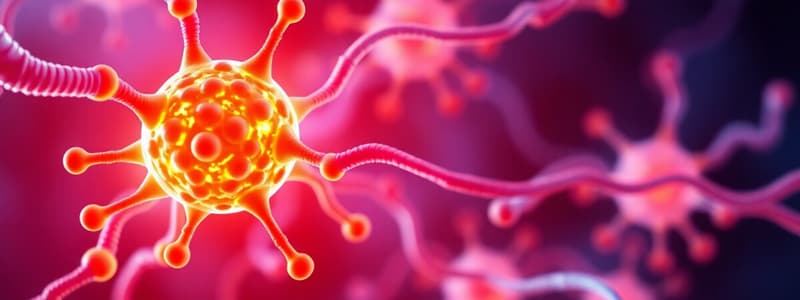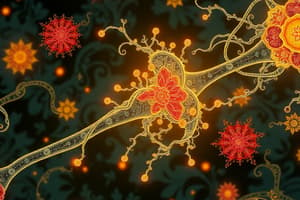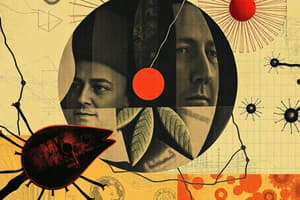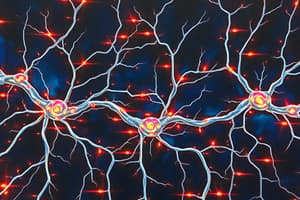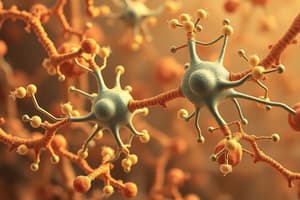Podcast
Questions and Answers
A drug that diminishes the effect of a particular neurotransmitter at a receptor is best described as:
A drug that diminishes the effect of a particular neurotransmitter at a receptor is best described as:
- A partial agonist, producing a maximal response.
- An agonist, enhancing the receptor's basal activity.
- An inverse agonist, initiating a response opposite to the neurotransmitter.
- An antagonist, reducing the neurotransmitter's efficacy. (correct)
Which of the following characteristics is NOT a typical feature of physiological receptors involved in signal transduction?
Which of the following characteristics is NOT a typical feature of physiological receptors involved in signal transduction?
- Modification of cellular function upon drug binding.
- Possession of a ligand-binding domain for drug interaction.
- Ability to directly synthesize new proteins upon activation. (correct)
- Propagation of a message via an effector domain.
In the context of signal transduction pathways, what is the most accurate description of the term 'receptor-effector coupling mechanism'?
In the context of signal transduction pathways, what is the most accurate description of the term 'receptor-effector coupling mechanism'?
- The receptor, its cellular target, and any intermediary molecules involved in signal propagation. (correct)
- The inherent ability of a receptor to bind to any ligand, regardless of its structure.
- The interaction between a drug and its target receptor only.
- The process by which a drug is metabolized and eliminated from the body.
Why are membrane lipid bilayers generally impermeable to polar molecules such as $Na^+$, $K^+$, $Ca^{2+}$, and $Cl^-$?
Why are membrane lipid bilayers generally impermeable to polar molecules such as $Na^+$, $K^+$, $Ca^{2+}$, and $Cl^-$?
Which of the following physiological processes does NOT prominently involve ion channels?
Which of the following physiological processes does NOT prominently involve ion channels?
A certain novel drug activates an ion channel by binding directly to it. Based on this mechanism of action, how would you classify this ion channel?
A certain novel drug activates an ion channel by binding directly to it. Based on this mechanism of action, how would you classify this ion channel?
What is the primary mechanism by which the nicotinic acetylcholine receptor (nAChR) transitions from a closed to an open state?
What is the primary mechanism by which the nicotinic acetylcholine receptor (nAChR) transitions from a closed to an open state?
In the nicotinic acetylcholine receptor (nAChR), what is the major ion that passes through the channel upon its activation, and what other ion can also permeate, albeit to a lesser extent?
In the nicotinic acetylcholine receptor (nAChR), what is the major ion that passes through the channel upon its activation, and what other ion can also permeate, albeit to a lesser extent?
Local anesthetics, such as lidocaine, affect neuron function by:
Local anesthetics, such as lidocaine, affect neuron function by:
Sulfonylurea drugs, like Glipizide, stimulate insulin secretion through which mechanism?
Sulfonylurea drugs, like Glipizide, stimulate insulin secretion through which mechanism?
What is the primary mechanism by which G protein signaling is terminated after receptor activation?
What is the primary mechanism by which G protein signaling is terminated after receptor activation?
Which of the following is a well-characterized effector molecule activated by G proteins, leading to the production of a second messenger?
Which of the following is a well-characterized effector molecule activated by G proteins, leading to the production of a second messenger?
Catecholamines, such as epinephrine and norepinephrine, stimulate cAMP production by directly interacting with:
Catecholamines, such as epinephrine and norepinephrine, stimulate cAMP production by directly interacting with:
Unlike G protein-coupled receptors, transmembrane receptors with enzymatic cytosolic domains typically:
Unlike G protein-coupled receptors, transmembrane receptors with enzymatic cytosolic domains typically:
Receptor tyrosine kinases (RTKs) initiate intracellular signaling cascades through:
Receptor tyrosine kinases (RTKs) initiate intracellular signaling cascades through:
Imatinib (Gleevec) is an anticancer drug that functions by:
Imatinib (Gleevec) is an anticancer drug that functions by:
Cytokine receptors, unlike receptor tyrosine kinases, typically:
Cytokine receptors, unlike receptor tyrosine kinases, typically:
Phosphorylation of a protein by a receptor kinase impacts protein function by primarily altering its:
Phosphorylation of a protein by a receptor kinase impacts protein function by primarily altering its:
How do Janus kinases (JAKs) contribute to intracellular signaling?
How do Janus kinases (JAKs) contribute to intracellular signaling?
What is the primary mechanism by which circulating steroid hormones affect cellular function?
What is the primary mechanism by which circulating steroid hormones affect cellular function?
Why do nuclear hormone receptors typically exhibit a 'lag on' and 'lag off' effect?
Why do nuclear hormone receptors typically exhibit a 'lag on' and 'lag off' effect?
How does nitric oxide (NO) affect soluble guanylyl cyclase (GC)?
How does nitric oxide (NO) affect soluble guanylyl cyclase (GC)?
What is the primary mechanism by which cGMP induces vasodilation in vascular smooth muscle?
What is the primary mechanism by which cGMP induces vasodilation in vascular smooth muscle?
Enalapril, an ACE inhibitor, is used to treat hypertension. Where is ACE primarily produced?
Enalapril, an ACE inhibitor, is used to treat hypertension. Where is ACE primarily produced?
How do acetylcholinesterase inhibitors, such as tacrine, exert their therapeutic effect in Alzheimer's disease?
How do acetylcholinesterase inhibitors, such as tacrine, exert their therapeutic effect in Alzheimer's disease?
Eptifibatide is a drug that antagonizes the platelet GPIIb-IIIa receptor. What physiological process does this antagonism primarily affect?
Eptifibatide is a drug that antagonizes the platelet GPIIb-IIIa receptor. What physiological process does this antagonism primarily affect?
Paclitaxel is a microtubule inhibitor used as an antineoplastic agent. What cellular function does it directly disrupt?
Paclitaxel is a microtubule inhibitor used as an antineoplastic agent. What cellular function does it directly disrupt?
Why is signal amplification important in cellular signaling pathways?
Why is signal amplification important in cellular signaling pathways?
Flashcards
Signal Transduction
Signal Transduction
Process where a cell converts one kind of signal/stimulus into another.
Receptor Functions
Receptor Functions
Binding a molecule and message propagation.
Drug Effects on Cells
Drug Effects on Cells
Drugs can start, increase, decrease, or stop cell function by binding to receptors.
Signal Pathway
Signal Pathway
Signup and view all the flashcards
Membrane Permeability
Membrane Permeability
Signup and view all the flashcards
Ion Channel Roles
Ion Channel Roles
Signup and view all the flashcards
Ion Channel Classification
Ion Channel Classification
Signup and view all the flashcards
Ligand-Gated Channels
Ligand-Gated Channels
Signup and view all the flashcards
Voltage-activated Na+ channels
Voltage-activated Na+ channels
Signup and view all the flashcards
Na+ Channel Inactivation
Na+ Channel Inactivation
Signup and view all the flashcards
Glipizide
Glipizide
Signup and view all the flashcards
GPCRs
GPCRs
Signup and view all the flashcards
G Proteins
G Proteins
Signup and view all the flashcards
Second Messengers
Second Messengers
Signup and view all the flashcards
Catecholamines
Catecholamines
Signup and view all the flashcards
Transmembrane receptors
Transmembrane receptors
Signup and view all the flashcards
Receptor Tyrosine Kinases (RTKs)
Receptor Tyrosine Kinases (RTKs)
Signup and view all the flashcards
Imatinib (Gleevec)
Imatinib (Gleevec)
Signup and view all the flashcards
Janus Kinases (JAKs)
Janus Kinases (JAKs)
Signup and view all the flashcards
Nuclear Hormone Receptors
Nuclear Hormone Receptors
Signup and view all the flashcards
Nuclear Receptor Domains
Nuclear Receptor Domains
Signup and view all the flashcards
Lag On Effect
Lag On Effect
Signup and view all the flashcards
Lag Off Effect
Lag Off Effect
Signup and view all the flashcards
Nitric Oxide (NO)
Nitric Oxide (NO)
Signup and view all the flashcards
cGMP Vascular Effects
cGMP Vascular Effects
Signup and view all the flashcards
ACE (Angiotensin-Converting Enzyme)
ACE (Angiotensin-Converting Enzyme)
Signup and view all the flashcards
Signaling Convergence
Signaling Convergence
Signup and view all the flashcards
Signal Amplification
Signal Amplification
Signup and view all the flashcards
Study Notes
- Physiological receptors mediate ligand binding via a ligand-binding domain and propagate messages via an effector domain.
- Drugs modify cellular function by binding to receptors, initiating, enhancing, diminishing, or terminating signals.
Signal Transduction Pathway
- This pathway, also known as the receptor-effector coupling mechanism, encompasses the receptor, its cellular target, and intermediary molecules.
Major Types of Drug Receptors
- Include ion channels, G protein-coupled receptors (GPCRs), transmembrane receptors with enzymatic cytosolic domains, and intracellular receptors.
Ion Channels
- Membrane lipid bilayers are largely impermeable to polar ions, requiring them to be non-polar and lipophilic to pass through.
- These channels play vital roles in neurotransmission, cardiac conduction, muscle contractions, and secretion.
- Classified by architecture, ions conducted, and activation mechanism, with ligand and voltage-activated channels being major drug targets.
Ligand-Activated Ion Channels
- They are diverse, with major types found in the CNS, responding to excitatory neurotransmitters like acetylcholine (ACh) or glutamate, and inhibitory neurotransmitters like glycine or GABA.
- The nicotinic acetylcholine receptor, found in skeletal muscle and neurons consists of 5 subunits (2-α, β, γ, δ) in skeletal muscle. Activation requires two ACh molecules binding to α subunits.
- Activation results in a conformational change, pore opening, and Na+ passage and K+ passage.
Voltage-Activated Ion Channels
- Examples include Na+, K+, Ca2+, and Cl- channels.
- Voltage-activated Na+ channels initiate action potentials, depolarizing the membrane from -70mV to +30mV, then becoming inactivated until reset.
- Drugs can exhibit state-dependent affinity, such as local anesthetics like lidocaine which prolong the refractory period.
Other Ion Channels
- These are activated by intracellular molecules, such as the sulfonylurea receptor (SUR1), which regulates the ATP-dependent K+ channel in pancreatic beta-cells.
- Sulfonylurea class oral hypoglycemics like Glipizide facilitate channel closure and insulin secretion by binding to SUR1.
G Proteins
- G protein-coupled receptors (GPCRs) are the most abundant class of receptors in the body, with humans expressing over 800 types dedicated to sensory perception and regulating various physiological functions.
- GPCRs can be activated by neurotransmitters, eicosanoids, peptide hormones, and opioids and are the targets of many drugs.
- GPCRs bind to heterotrimeric GTP-binding regulatory proteins termed G proteins.
- Signals from G proteins are usually terminated by hydrolysis of GTP to GDP by inherent GTP-ase activity of the alpha subunit.
- G proteins activate effector molecules, producing second messengers like adenylyl cyclase, guanylyl cyclase, phospholipase C, and various ion channels.
- While G alpha subunit isoforms are well-known, βγ subunit isoforms can regulate K+ and Ca2+ channels.
β-Adrenergic Receptor Group
- This is an important receptor class in the G protein receptor family.
- Catecholamines (epinephrine and norepinephrine) are endogenous ligands, stimulating cAMP production and tissue-specific cellular effects.
Transmembrane Receptors
- These receptors have enzymatic cytosolic domains and play essential roles in cell metabolism, growth, and differentiation; tonic activation can cause tumors.
- Unlike GPCRs, they consist of single membrane-spanning proteins and often form dimers or multi-subunit complexes for signal transduction.
- Receptor activity includes adding/removing phosphate groups from specific amino acids like phosphorylation.
Receptor Tyrosine Kinases
- It is the largest group of this receptor class.
- Endogenous ligands include insulin, PDGF, and VEGF. Effectors include SH2 domains on signaling molecules like Grb2.
- Imatinib (Gleevec) is a TK inhibitor used as an anticancer agent targeting BCR-Abl TK in chronic myelogenous leukaemia.
Tyrosine Kinase-Associated Receptors
- Includes cytokine receptors like γ-interferon and growth hormone and prolactin receptors.
- These receptors lack intrinsic enzymatic activity; dimerization allows binding of intracellular tyrosine kinases like Janus Kinase (JAK).
- JAKs phosphorylate other proteins (STAT), which translocate to the nucleus.
Intracellular Receptors
- Nuclear hormone receptors: circulating steroid hormones are lipophilic, diffusing through the plasma membrane to bind transcription factors.
- Receptors possess a ligand-binding domain and a DNA-binding domain.
- Nuclear events depend on co-activators or co-repressors of gene transcription.
- Gene transcription is slow but has long-lasting effects, exhibiting a lag on (slow onset) and lag off (slow offset).
Nitric Oxide (NO)
- It is a labile gas produced locally, especially in the cardiovascular system via endothelial (eNOS), inductible (iNOS), and neuronal (nNOS) isoforms.
- NO binds to the N-terminal domain of soluble guanylyl cyclase (GC), enhancing cGMP activation.
Vascular Smooth Muscle Effects of cGMP
- Mainly due to cGMP acting on PKG, leading to vasodilation from reduced intracellular calcium levels. e.g., nitrovasodilators and angina pectoris.
Other Drug Receptors
- Some drug receptors exist outside the plasma membrane with roles such as communication: ACE inhibitors (enalapril) for hypertension.
- Neurotransmitter: acetylcholinesterase inhibitors (tacrine) for Alzheimer's disease.
- Cell surface adhesion function: Eptifibatide, an antagonist of the platelet GPIIb-IIIa receptor, inhibits platelet aggregation.
- Structure: Microtubule inhibitors (paclitaxel) for cancer therapy.
Cellular Signal Integration
- Signaling convergence by second messengers can generate coordinated net cellular effects.
Signal Amplification
- The magnitude of a cellular response to a ligand is generally greater than the initiating stimulus.
Cellular Regulation of Receptors
- Drug-induced activation or inhibition of a receptor can have a long-lasting effect on subsequent responsiveness to drug binding.
Studying That Suits You
Use AI to generate personalized quizzes and flashcards to suit your learning preferences.
